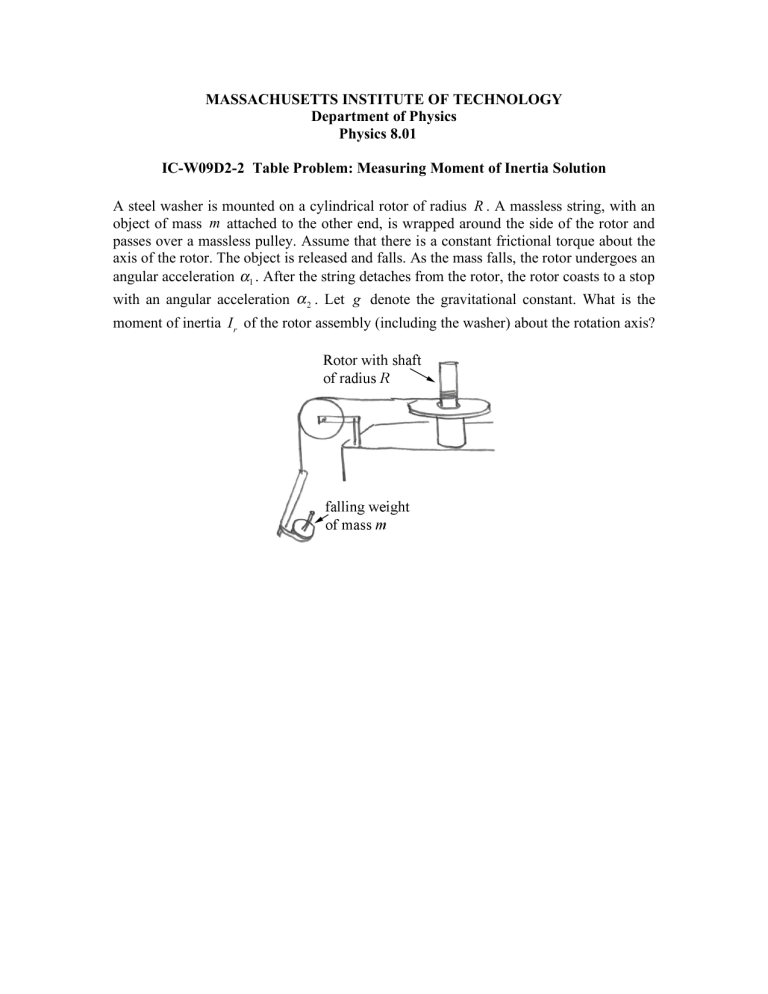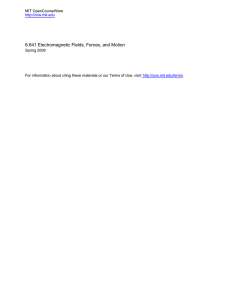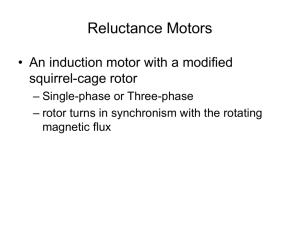Moment of Inertia Problem Solution: Physics 8.01

MASSACHUSETTS INSTITUTE OF TECHNOLOGY
Department of Physics
Physics 8.01
IC-W09D2-2 Table Problem: Measuring Moment of Inertia Solution
A steel washer is mounted on a cylindrical rotor of radius R . A massless string, with an object of mass m attached to the other end, is wrapped around the side of the rotor and passes over a massless pulley. Assume that there is a constant frictional torque about the axis of the rotor. The object is released and falls. As the mass falls, the rotor undergoes an angular acceleration !
1
. After the string detaches from the rotor, the rotor coasts to a stop with an angular acceleration moment of inertia
I r
!
2
. Let
g
denote the gravitational constant. What is the
of the rotor assembly (including the washer) about the rotation axis?
Solution: For the rotor, choose cylindrical coordinates as shown in the figure on the left below.
Use !
f
to denote the magnitude of the frictional torque. While the mass is falling, the rotor/washer combination has a torque due to the tension in the string and the frictional torque. The angular acceleration vector is denoted by
The torque law, !
) ˆ .
!
1
= !
1
ˆ the center of the rotor (point P ) is given by
P
= I r 1
!
P
= ( TR " !
f
for fixed axis rotation then becomes
. Then the torque about
(1.1)
TR !
" f
= I r
#
1
. (1.2)
Equation (1.2) contains the unknown frictional torque, and this torque is determined by considering the slowing of the rotor/washer after the string has detached. The net torque on the system is just this frictional torque, and so
!
" f
= I r
#
2
. (1.3)
Note that in Equation (1.3), !
f
and !
i.e. the rotor is slowing down.
2
have opposite signs, consistent with the fact that
!
2
< 0
The figure above on the right shows the free body force diagram for the falling weight.
Newton’s Second Law becomes
mg
!
T = ma
1
. (1.4)
Because the string does not stretch or slide on the rotor, the acceleration of the string is related to the angular acceleration of the rotor by
a 1
= R !
1
. (1.5)
Substituting Eq. (1.5) into Eq. (1.4) yields
mg
!
T = mR "
1
We can now substitute !
f
(from Eq. (1.3)), and T
. (1.6)
from Eq. (1.6) into Eq. (1.2) yielding
(( mg !
mR "
1
)) R + I r
"
2
= I r
"
1
(1.7)
We can now solve for
I r
yielding
I r
= mR ( g !
R "
1
)
"
1
!
"
2
(1.8)

